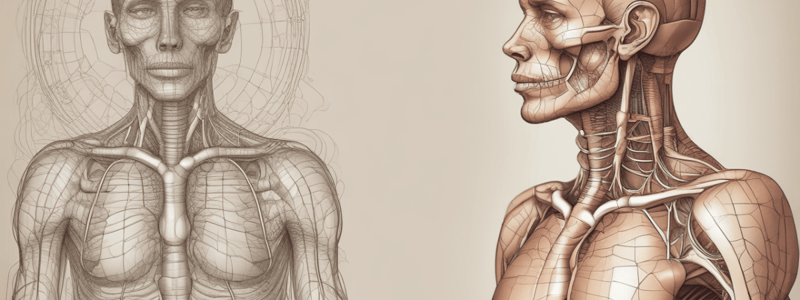Podcast
Questions and Answers
What is the primary function of the surfactant produced by type II alveolar cells?
What is the primary function of the surfactant produced by type II alveolar cells?
- To facilitate gas exchange by increasing the surface area of the alveoli
- To stimulate the contraction of diaphragmatic muscles during inspiration
- To reduce the surface tension of water in the alveoli, preventing collapse (correct)
- To regulate the pH of the alveolar airspaces
Which of the following respiratory muscles is responsible for approximately 70% of the inspiratory effort?
Which of the following respiratory muscles is responsible for approximately 70% of the inspiratory effort?
- Diaphragm (correct)
- Internal intercostal muscles
- Accessory muscles, including the scalene and sternocleidomastoid muscles
- External intercostal muscles
What is the term for the movement of air into the lungs during inspiration?
What is the term for the movement of air into the lungs during inspiration?
- Pressure
- Flow
- Ventilation (correct)
- Volume
What is the term for the amount of air that remains in the lungs after forceful exhalation?
What is the term for the amount of air that remains in the lungs after forceful exhalation?
What is the term for the volume of air that can be exhaled from the lungs after normal exhalation?
What is the term for the volume of air that can be exhaled from the lungs after normal exhalation?
What is the primary mechanism by which the diaphragm contracts during inspiration?
What is the primary mechanism by which the diaphragm contracts during inspiration?
Which of the following factors contributes to the decrease in lung compliance during pulmonary edema?
Which of the following factors contributes to the decrease in lung compliance during pulmonary edema?
During forced expiration, which of the following muscles is responsible for compressing the thoracic cavity?
During forced expiration, which of the following muscles is responsible for compressing the thoracic cavity?
What is the result of the shift of the oxygen-hemoglobin dissociation curve to the right?
What is the result of the shift of the oxygen-hemoglobin dissociation curve to the right?
What is the purpose of the Hering-Breuer reflex?
What is the purpose of the Hering-Breuer reflex?
What is the primary effect of increased intra-alveolar pressure on the alveolar-capillary membrane?
What is the primary effect of increased intra-alveolar pressure on the alveolar-capillary membrane?
What is the primary mechanism by which the parasympathetic nervous system regulates respiration?
What is the primary mechanism by which the parasympathetic nervous system regulates respiration?
What is the effect of a shift of the oxygen-hemoglobin dissociation curve to the left on oxygen delivery to tissues?
What is the effect of a shift of the oxygen-hemoglobin dissociation curve to the left on oxygen delivery to tissues?
What is the primary function of the apneustic center in the brainstem?
What is the primary function of the apneustic center in the brainstem?
What is the effect of an increase in pulmonary vascular resistance on the perfusion of the lungs?
What is the effect of an increase in pulmonary vascular resistance on the perfusion of the lungs?
What is the primary mechanism that allows the diaphragm to generate a greater pressure difference during inspiration?
What is the primary mechanism that allows the diaphragm to generate a greater pressure difference during inspiration?
Which of the following factors would increase the work of breathing?
Which of the following factors would increase the work of breathing?
What is the primary effect of a decrease in respiratory rate on the partial pressure of CO2 in the arterial blood?
What is the primary effect of a decrease in respiratory rate on the partial pressure of CO2 in the arterial blood?
What is the primary role of the dorsal respiratory group in the regulation of respiration?
What is the primary role of the dorsal respiratory group in the regulation of respiration?
Which of the following would result in a decrease in the partial pressure of O2 in the alveoli?
Which of the following would result in a decrease in the partial pressure of O2 in the alveoli?
What is the primary effect of a decrease in the diameter of the airways on the lungs?
What is the primary effect of a decrease in the diameter of the airways on the lungs?
What is the result of the stimulation of the apneustic center?
What is the result of the stimulation of the apneustic center?
What is the primary effect of a decrease in the partial pressure of CO2 in the arterial blood on the respiratory rate?
What is the primary effect of a decrease in the partial pressure of CO2 in the arterial blood on the respiratory rate?
What is the primary effect of an increase in the surface tension of the alveolar fluid on the lungs?
What is the primary effect of an increase in the surface tension of the alveolar fluid on the lungs?
What is the primary effect of a decrease in the phrenic nerve activity on the diaphragm?
What is the primary effect of a decrease in the phrenic nerve activity on the diaphragm?
Flashcards are hidden until you start studying




